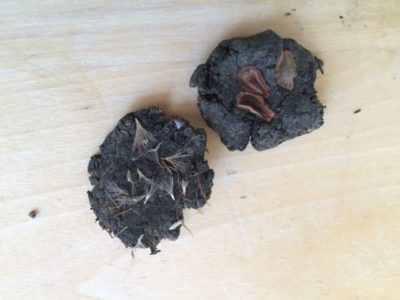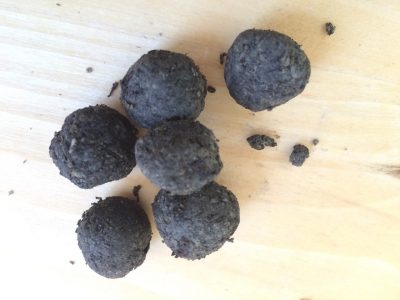Native Seed Balls – Dispersing Seeds with Guerilla Action
by Heather McCargo
There is something satisfying about the idea of tossing seeds of wild flowers or trees into an empty area with the hope that it will magically turn into a flowery meadow or forest. After all, seeds scatter in nature by chance. Seeds blow in the wind, stick to the body of an animal, drop to the ground, or get eaten by animals and excreted in a distant location. This is called seed dispersal.
What most people don’t realize is that a very small percentage of the seeds that a plant produces actually make it to adulthood – often no more than 1%. Life is indeed a challenge, and the chance that a seed will land in a spot where it gets the right amount of moisture and space to germinate, and then make it through all the trials of youth to adulthood, is rare. No wonder most people have little success when they simply toss some seeds into an unmanaged area.
The ancient art of encasing seeds in earthen balls and spreading them in areas devoid of vegetation was revived in the 1970’s by Masanobu Fukuoka, the pioneer of Japanese natural farming, in his book One Straw Revolution. Since that time there has been a grassroots movement to create these so-called “seed balls” to improve the low success rate of wild seed dispersal. Clay and organic matter are mixed with seeds and thrown into abandoned lots, roadsides, railway lines, deforested lands, and anywhere one hopes to add more plant species. While there is no science demonstrating the effectiveness of this method of seed dispersal, it is an interesting and fun way to engage people in restoring vegetation, particularly if seeds of native species are used.
In urban and suburban areas, where much of the native vegetation has been removed, seed balls can be used to reintroduce seeds of some of Maine’s indigenous plants to help re-establish native populations. Below I will explain how to make native seed balls and recommend which species are likely to be successful with this kind of guerrilla seed sowing.
How and When to Seed Ball


Fall to early spring is the best time to make and throw seed balls. The seeds of many northern species need to experience a winter cold period before the seeds will germinate. Sowing the seeds during the cold and wet time of year will give these seeds the best chance to work their way into a soil niche and provide the cold stratification they need for germination. By mid-May, the landscape begins to warm and the soil dries out. This makes late spring a more risky environment for seed germination if you cannot provide supplemental water.
It is also important to know that many native trees, shrubs and wildflowers have seeds that cannot dry out. For example, acorns must be collected and stored in a zip-lock bag in the refrigerator. If you let them sit around on the dashboard of your car or in your house, they will die. Therefore, before collecting seeds, make sure you have researched the seed storage and germination requirements of the species you are planning to use in seed balls.
To make the seed balls, the ingredients are simple: clay, organic matter, water and a pinch of seeds. Mix equal parts compost or potting soil with clay (potters clay or cat litter clay with no added chemicals) with a little bit of water until you have a dough that sticks together but is not soggy. Experiment with rolling it into pea size balls. Next press your finger into the ball to create a bowl shape. This is where you will place a pinch of seed. For large seeds like milkweed, use 3 seeds; for small seeds a pinch will do. Gently roll the seed into the inside of the ball and set aside. If you are using large seeds such as acorns, you will need a golf ball size ball. Seeds from maple, ash or wild cherry will need a ball the size of a grape. The seed balls can be left out for a couple of hours to firm up, but you do not want them to dry out inside. They should then be stored in a plastic bag in the refrigerator until you are ready to engage in your guerilla seed balling action. Please remember that this is not an action for state or national parks or your local conservation land (unless they have given you specific approval). Try this in your yard, neighborhood, school, or other private land with permission from the landowner.
Recommended species
 A list of the species that I think are likely candidates to work for seed balls in the Northeast is provide below. I recommend making seed balls with just one species or at least combining the seeds by habitat requirements. Remember that most native wildflowers take at least a year to reach maturity and bloom. Trees take much longer but are easy to identify by their leaves even when young. If this proves successful, you may have helped some native species return to your neighborhood and provide food and habitat for many creatures. Have fun, and send us pictures.
A list of the species that I think are likely candidates to work for seed balls in the Northeast is provide below. I recommend making seed balls with just one species or at least combining the seeds by habitat requirements. Remember that most native wildflowers take at least a year to reach maturity and bloom. Trees take much longer but are easy to identify by their leaves even when young. If this proves successful, you may have helped some native species return to your neighborhood and provide food and habitat for many creatures. Have fun, and send us pictures.
Sunny and Moist Soils
New England aster Symphyotrichum novae-angliae
Tall white aster Doellingeria umbellata
Swamp milkweed Asclepias incarnata
Common milkweed Asclepias syriaca
Blue Vervain Verbena hastata
Rosy meadowsweet Spirea tomentosa
Boneset Eupatorium perfoliatum
Joe-pye weed Eutrichium spp.
Wild clematis Clematis virginiana
Switch grass Panicum virgatum
Sunny and Dry Soils
Black eyed coneflower Rudbeckia hirta
Beardtongue Penstemon digitalis and P. hirsutus
Wild Rose Rosa virginiana
Meadowsweet Spirea alba
Little Bluestem Schizachyrium scoparium
Butterfly milkweed Asclepias tuberosa
Smooth blue aster Symphyotricum laevis
Downy goldenrod Solidago puberula
Wild Strawberry Fragaria virginiana
Shady Soils with Medium Moisture
Blue wood aster Symphyotrichum cordifolium
Large-leaved wood aster Eurybia macrophylla
White snakeroot Ageratina altissimo
Woodland goldenrod Solidago caesia, S. flexicaulis
Crane’sbill Geranium maculatum
Golden grounsel Packera aurea
Tree Species
Oaks Quercus spp.
Maple Acer spp.
Ash Fraxinus
Wild cherry and plum Prunus spp.
Birch Betula
Seeds are for sale on our online store, both as individual species packets and as four seed ball mixes for various growing conditions.
Read more about germinating native seeds.
For extensive information on germinating seeds, see William Cullina’s Growing and Propagating Wildflowers and Native Trees, Shrubs and Vines.
Native Gardening Blog
After removing disruptive introduced species, try planting these
Join Our Team!
Landscaping in partnership with native ecosystems is good for the planet. It’s good for us too.
Building Biodiverse & Climate-Resilient Habitats
Supporting Ash Protection Collaboration Across Wabanakik

